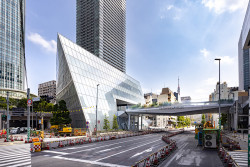
November 23, 2006
Agamachi
Fox fires and bar codes help a rural Niigata town reinvent itself
By Metropolis
Originally published on metropolis.co.jp on November 2006

Photos by Marie Iida
To a solitary traveler arriving from the concrete jungle of Tokyo, the town of Agamachi, on the eastern edge of Niigata Prefecture, offers nothing short of a fantasy straight out of a Hayao Miyazaki film. The town is home to the largest cedar tree in all of Japan, an enigmatic mountain said to be haunted by spirits, and the Agano River, which remains just as mighty as when the 19th-century British writer Isabella Bird traveled along its rocky terrain. A locale of natural grace and beauty that eschews the manmade pretensions of Japan’s more mainstream tourist hotspots, Agamachi is known as “Shangri-La” to its convivial residents.
Agamachi lies a three-hour train ride from Tokyo station, and was formed less than two years ago when four towns—Tsugawa, Kanose, Mikawa and Kamikawa—fell into financial difficulties and decided to consolidate themselves into one. At a time when most Japanese are prefering to travel overseas, Agamachi’s story is emblematic of the country’s struggling rural areas: though 1.5 times the size of the 23-ward Tokyo area, its population is just over 15,000.
While some Agamachi hotels offer transportation services, and while innkeepers are eager to give impromptu driving tours to travelers, the town is undeniably difficult to get around for anyone without a car or bicycle. Yet Agamachi has embraced a decidedly modern technology to help lure savvy travelers. As they make their way through the area, tourists will notice that QR codes—those barcodes that can be optically read by a mobile phone camera—are curiously ubiquitous.

At Agamachi’s modest or high-end ryokan, QR codes in the lobbies will help you locate everything from transportation to emergency numbers to local restaurants to gift shops. They can also help you choose from the town’s eight different kinds of onsen, or show a step-by-step video guide to the creation of washi—which you can then experience in person at Furusato-kan, an interactive museum facility.
Even at the Byodo-ji temple, located a 20-minute walk from Agamachi’s Igashima station, travelers will find QR codes that take them directly to a website providing a detailed guide in English, Japanese or Chinese. Information about the history of the temple is on offer, as well as details about Shogun-sugi, the 1,400-year-old cedar tree that’s over 19 meters in circumference and 40 meters tall.
Introducing such a cutting-edge attraction to an aging population has not always been easy. When asked to elaborate on the sacrifices the town had to make to draw people back to the area, Agamachi’s former mayor, Toji Hasegawa, smiled sheepishly and conceded, “It’s a bit of a struggle for everyone here, but we must accept the challenges for the future of the town.”
Whether or not it draws tourists, the technology works for the simple fact that Agamachi has history, traditions and legends in spades. Perhaps the most intriguingly eerie tale is about the wedding procession of the Tsugawa foxes. In the distant past, Kirin Mountain, located between the Agano and Tokonami rivers, was populated by wild animals. The mountain (named after the imaginary beast seen on the cans of Kirin beer) was also a spot where locals witness kitsunebi (“fox fire,” or ignis fatuus), a pale light that sometimes appears over marshy ground. Because the ghostly glow resembled the band of paper lanterns seen in traditional Japanese wedding processions, local residents believed that a gang of foxes were holding a wedding ceremony atop the mountain.
In a tradition that continues today, a real-life bride and groom dress in Edo-era costumes with their faces painted like foxes to reenact the legend each year on May 3. The people of Tsugawa also paint their faces, and they follow the couple down to the bank of the Tokonami River to complete the stately wedding ceremony and banquet at night.
The highlight of any Agamachi tour, however, must be the leisurely boat cruise along the Agano River, counted among Japan’s 100 most beautiful spots. During the hour-long boat ride, a jovial tour guide sings an old song that describes the river’s mighty currents.
The current of the times may not be easy on a country town like Agamachi, but with its rich legends, traditions and hospitality—as well as its progressive use of technology—this hamlet in the mountains retains its graceful charm and welcoming air.
Agamachi can be reached by shinkansen from Tokyo to Niigata station, then by taking the JR Hokuetsu Limited Express to Niitsu Station, followed by the JR Banetsu Saisen line to Tsugawa. The trip takes approximately 3 hours and costs ¥11,730. The lodge-style hotel Akasakiso (11540-1 Kanose, Agamachi; 02549-2-5811; www.akasaki.jp) boasts a 24-hour onsen with a great view. The owner speaks good English, and will drive guests to and from the station. A basic room is ¥8,235 for adults, ¥6,930 for children (includes breakfast and dinner). Each four regions of Agamachi offers hot springs; try Akayu Onsen, a spa and dining facility that costs just ¥200 (0254-92-4188); it was chosen as Japan’s number one onsen by Komachi magazine. Attractions in Agamachi include the Furusatokan (11540-7 Kanose; 0254-92-4508), where you can see stunning Japanese paper lanterns and try making one for yourself as well. The boat cruise along the Agano river (11540 Kanose, Agamachi; 0254-92-5629) costs ¥1,600 for adults and ¥800 for children. It’s worth a try in any season.
[geo_mashup_map]







